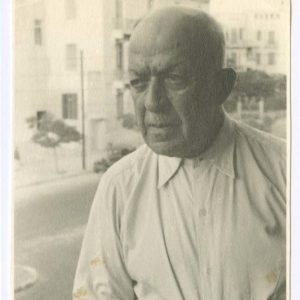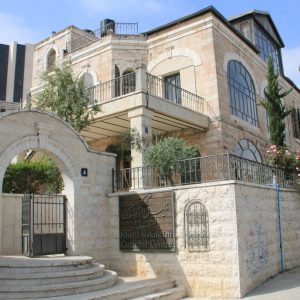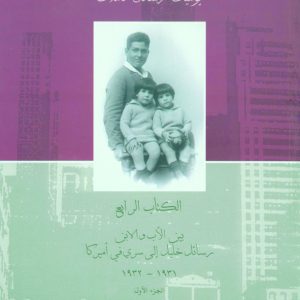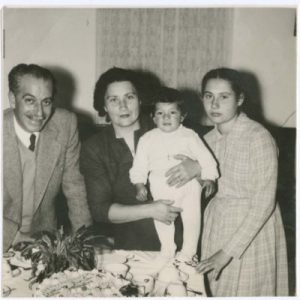Khalil Sakakini at Khalil Sakakini
Who is Khalil Sakakini

Khalil Sakakini was born in Jerusalem on January 23rd, 1878 and received his education at the Greek Orthodox School first, then the he attended C.M.S School. After graduating from C.M.S school he enrolled at the English School of Zion where he learned literature on the hands of the educator Nakhla Zureik. After the death of his father in 1907 he traveled to Britain and then to the United States to study educational studies, but due to financial issues he was unable to complete his education and decided to return to his birthplace in 1908. During his time in the United States he worked as a translator and Arabic teacher. Towards the end of his journey in the United States, he had to work in a paper factory to pay the expenses of his return ticket. Additionally, he wrote several articles that were published in journals dedicated to Arabic literature.
Sakakini came back to Palestine to work with “Al-Asma’i” journal in Jerusalem, in addition to his work as the Arabic Language Teacher at ”al-Salahiyyeh” School, and at the American Colony in Jerusalem. In 1908, Sakakini led a popular movement to arabize and reform the Orthodox Church in Palestine, where this led to his disengagement from the church. In 1909 he established the “Constitutional School”, which was known for its Arab Nationalist thought. In line with his religious reform campaign, this school was the first of its kind in Palestine to include students and teachers from different sects and social circles. He has also initiated the anti-competition and award elimination teaching methodology, which he followed in all the schools that he established afterwards. Besides, infiltrating the teaching of arts and physical education to the curriculum.
Against the backdrop of the First World War, the Ottoman authorities arrested Sakakini in 1917 and imprisoned him in Damascus, where he was then released on bail in early 1918. Sakakini worked in the governmental Knowledge Authority in Jerusalem, and was assigned as a general inspector with them for 12 years. In 1925 he established the “National School”, and in 1938 he established “al-Nahdah” College. The latter was an important educational college and a distinguished national and political forum. It was run by him until he was forced to close it upon the bombardment of Jerusalem in 1948.
In 1939 his wife, Sultana, passed away suddenly and he was distressed by her loss. He wrote a collection of poems in her memory, followed by a life with obsessions of solicitude. In 1948, days before the division of Jerusalem, Sakakini and his family left their home in the Qatamoun neighborhood to Cairo, and his family were one of the last remaining families in the neighborhood, which was terrorized by Israeli shelling.
Later in 1948, the Israeli Occupation seized his home and his rich library, where they scattered his books that were later annexed by the library of the Hebrew University. In Cairo he joined the Arabic Language Academy upon nomination by Taha Hussein. In that year, he was elected to be the first president of the Palestinian National Council.
The sudden death of his only son, Sari, following the former losses, left Sakakini in poor health conditions. He died three months after the death of his son on August 13, 1953 and was buried in the tomb of St. George in Cairo. Nonetheless, his two daughters, Dumya and Hala, lived up to his name and had a distinctive path in higher education.
Khalil Sakakini Cultural Center
 The center was named after Khalil Sakakini, an intellectual and educational philosopher, one of the founders of the Palestinian national culture, and one of the most prominent contributors to its identity. Naming the center after Khalil Sakakini was inspired by his pioneering message and creative vision of humanity in general, and the Palestinian nation in particular, and we quote him, “If you want a nation to rise; wake their sense of beauty and then sleep. When you do so, people would perceive virtue as beautiful and so they would not tend to vice. They would perceive knowledge as beautiful and so they would not be satisfied with ignorance. They would perceive goodness as beautiful and so they would not lean to evil.”
The center was named after Khalil Sakakini, an intellectual and educational philosopher, one of the founders of the Palestinian national culture, and one of the most prominent contributors to its identity. Naming the center after Khalil Sakakini was inspired by his pioneering message and creative vision of humanity in general, and the Palestinian nation in particular, and we quote him, “If you want a nation to rise; wake their sense of beauty and then sleep. When you do so, people would perceive virtue as beautiful and so they would not tend to vice. They would perceive knowledge as beautiful and so they would not be satisfied with ignorance. They would perceive goodness as beautiful and so they would not lean to evil.”It is also worth mentioning that his daughters, Dumya and Hala, contributed in establishing the center.
The center displays some of Khalil Sakakini’s personal belongings in cabinets with glass facades on the main floor. On the shelves, you can see some of his family pictures, fez (tarboosh), his personal card, his handkerchief, his turban, and his wooden stick that was twisted from the top, as well as some cards that were handwritten by him. Some of the volumes of his books “Aljadeed in Reading Arabic” are still on one of the shelves besides his handwritten diaries. The center also maintains a collection of his family photo albums and books that remained after the theft of his library by the Israeli occupation in 1948. Additional, there are three books for his daughter Hala that are mainly her memoirs with her father and family, in addition to other personal belongings. The Center, in cooperation with the Institute of Jerusalem Studies, published the diaries of Khalil Sakakini in eight volumes, which are available at the center: * The Diaries of Khalil Sakakini (Diaries, Letters and Reflections), Volume I: New York, Sultana, Jerusalem (1907-1912). * The Diaries of Khalil Sakakini (Diaries, Letters and Reflections), Volume II: The Orthodox Renaissance, The Great War, The Exile to Damascus (1914-1918). * The Diaries of Khalil Sakakini (Diary, Letters and Reflections), Volume III: Testing Mandate and Identity Questions (1919-1922). * The Diaries of Khalil Sakakini (Diaries, Letters and Reflections),Volume IV: Between Father and Son, Letters of Khalil Sakakini to Sari in America (1931-1932), Part I. * The Diaries of Khalil Sakakini (Diaries, Letters and Reflections),Volume V: Between Father and Son, The Letters of Khalil Sakakini to Sari in America (1933-1934) Part II. * The Diaries of Khalil Sakakini (Diaries, Letters and Reflections), Volume VI: Between father and son, letters of Khalil Sakakini to Sari in America (1935-1937) Part III. * The Diaries of Khalil Sakakini (Diaries, Letters and Reflections), Volume VII: The Death of Sultana (1939-1941). * The Diaries of Khalil Sakakini (Diary, Letters and Reflections), Volume VIII: Exodus from Qatamun (1942-1952). * The Diaries of Khalil Sakakini, Life, This is How I am. 1955.
Books and Publications
 Khalil Sakakini left more than twelve books, that include linguistic books, educational curricula, poetry divan, and several articles on literature, ethics and politics. Nevertheless, his outstanding work was undoubtedly the “Al-Jadeed” book series that he integrated as part of the curriculum for teaching Arabic in primary schools in Palestine. It has been used by most educational institutions in Palestine and some Arab countries for four decades.
Khalil Sakakini left more than twelve books, that include linguistic books, educational curricula, poetry divan, and several articles on literature, ethics and politics. Nevertheless, his outstanding work was undoubtedly the “Al-Jadeed” book series that he integrated as part of the curriculum for teaching Arabic in primary schools in Palestine. It has been used by most educational institutions in Palestine and some Arab countries for four decades.* Following The Others’ Footsteps, (Jerusalem, 1896).
* The Orthodox Renaissance in Palestine (Jerusalem, 1913).
* Palestine after the Great War (Jerusalem, 1925).
* Studies in Language and Literature (Jerusalem, 1925).
* Sari (Jerusalem, 1935).
* Footnote to the Report of the Committee to Consider Facilitating the Rules of the Arabic Language (Jerusalem, 1938).
* In your memory (Jerusalem, 1940).
* Thus Measure (Jerusalem, 1943).
* Ma Tayassar (The available) – two volumes (Jerusalem, 1943, 1946).
* Al-Jadeed in Reading Arabic – Four volumes (Jerusalem, 1924-1933) – Some volumes are available at the center.
* The Essentials of Teaching Arabic Language – The First and Second Guide (Jerusalem, 1934, 1936)
* Life, This is How I am – Biography (Jerusalem, 1955).
* My Dears – Excerpts from his works collected and published by his daughter (Jerusalem, 1978).
* Milestones of Ancient History – Translation in cooperation with Wasfi Anabtawi and Ahmed Khalifa (1942).
* The Diaries of Khalil Sakakini – Eight volumes (Institute of Jerusalem Studies in Ramallah and Khalil Sakakini Cultural Center, 2003-2005).
* The Complete Collection of Sakakini (Jerusalem 1962) – The second volume is available at the center.
* Sakakini also had a historical manuscript, including Adam’s book, in addition to many articles published in Arabic newspapers and magazines.
His complete works were published in two volumes:
* On Literature – Literary articles by Sakakini (Jerusalem, 1962).
* Linguistic articles by Sakakini
Other books on Khalil Sakakini
* Khalil Sakakini, the reformer writer, Dr. Ishaq Musa al-Husseini (1989).
* Khalil Sakakini, The Linguist – Essam Mohammed al-Shanti, (Institute of Arab Research and Studies, 1967).
* In memory of Khalil Sakakini, the articles of the memorial ceremony on 9/9/1955 in Amman (Jerusalem, 1957).
* Personal archive in English, Hala Sakakini.
* Duo, Hala Sakakini (Jerusalem, 1993).
* Years in Ramallah, Hala Sakakini (Jerusalem, 1997).
* Jerusalem and I, Hala Sakakini (Jerusalem 2000).
Photo Archieve
Our archive at the centre regarding Khalil Sakakini includes family albums, and some of his rare books. These books are not for sale. We are in the process of republishing most of them in cooperation with the Institute of Jerusalem Studies. We are also delighted to be partners with others who are interested in publishing his works.
Books and Publications
Coming soon...






































